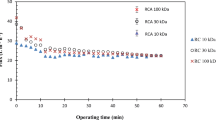Abstract
A process of aqueous degreasing is proposed, avoiding the use of organic solvents, in order to reduce fat substances present in sheepskins. Efficiency of the new process was increased coupling the degreasing to a pressure-driven membrane operation such as ultrafiltration. Increasing ultrafiltration time from 200 to 300 minutes yielded an increase of fats removal from 46% to 55% of the initial content. At 52 °C, the permeate flux decreased only 12.7% in 300 minutes. Recycling the permeate, that is the aqueous surfactant solution, permitted to save fresh water significantly compared to the open-washing system. Studies of membrane cleaning, using an enzymatic washing solution, showed a restore of the initial flux. A theoretical analysis was developed to decribe the behaviour of the mentioned system.
Similar content being viewed by others
Author information
Authors and Affiliations
Additional information
Received: 11 February 1999 / Accepted: 12 May 1999
Rights and permissions
About this article
Cite this article
Cassano, A., Criscuoli, A., Drioli, E. et al. Clean operations in the tanning industry: aqueous degreasing coupled to ultrafiltration . Clean Products and Processes 1, 257–263 (1999). https://doi.org/10.1007/s100980050039
Issue Date:
DOI: https://doi.org/10.1007/s100980050039




